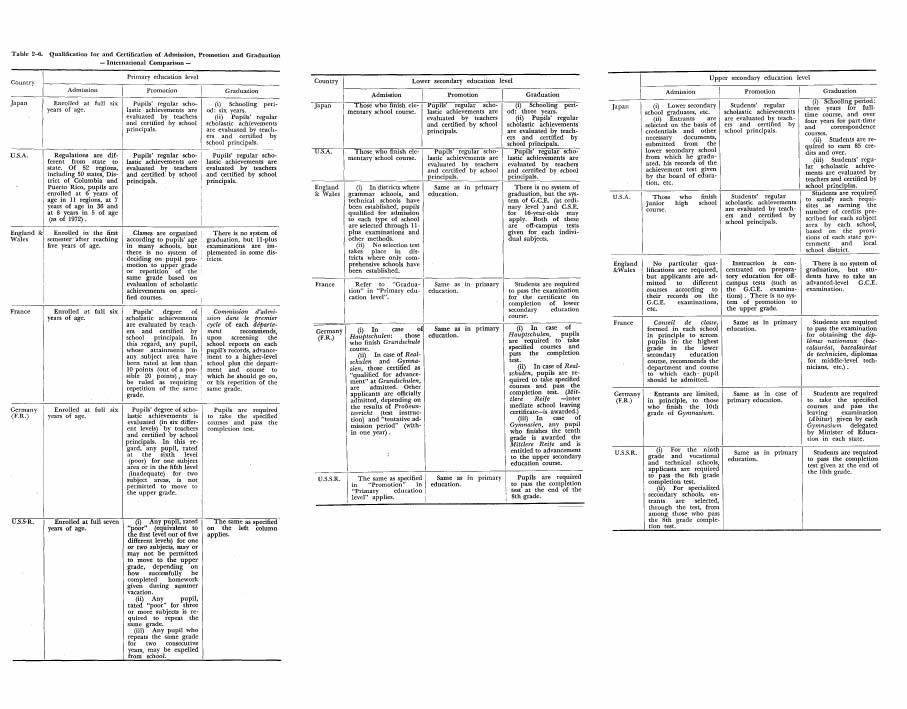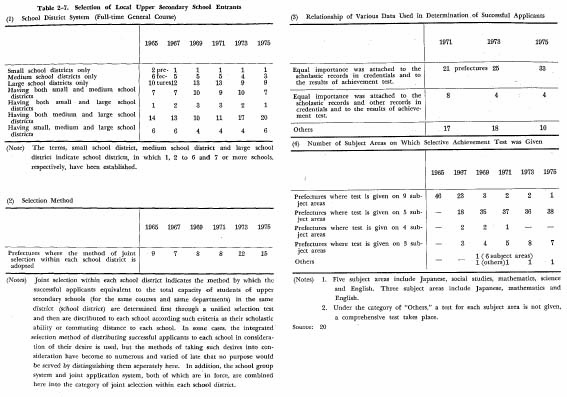| Home > Policy > White Paper, Notice, Announcement > White Paper > EDUCATIONAL STANDARDS IN JAPAN 1975 > CHAPTER2 3 (1) | ||
While the system of selection of entrants in secondary education was outlined previously under the sub-section titled "Qualification for and Certification of Admission and Graduation" (Cf. Table 2-6), change in the method of selecting the entrants into local upper secondary schools in Japan is to be observed below.
Entrants into local upper secondary schools are selected on the basis of the credentials and other necessary documents concerning the applicants, sent by the principals of lower secondary schools from which they graduated and their records of the achievement tests administerd by the prefectural boards of education concerned, and other information.

In this regard, with a view, to rectifying the so-called inter-school gap and rationalizing the study load of lower secondary school pupils, arduous efforts for reforming the selection system for local upper secondary school pupils have been carried on in recent years under the initiative of prefectural boards of education.
The principal alms of the reform include reorganization of the school district system, improvement of the selection methods (introduction of the joint selection system, etc.), effective use of various data for selection of entrants (attaching importance to credentials and the like), reduction of the number of subject areas on which the achievement tests are to be given and so forth.

The reforms on these four points, as mentioned above, implemented over the last ten years are shown in Table 2-7 in relation to the change in the number of prefectures where such reforms were carried out.
As for reorganization of the school district system in regard to selection of entrants into the full-time general course, the number of prefectures instituting only medium-size school districts or only large-size school districts has been on gradual decline, while those prefectures where both the middle-size and large-size school districts have been instituted, are on gradual increase.
As for the student selection method, the school-to-school separate selection method alone, under which each applicant applies to one upper secondary school in a certain school district and the selection is made by each school, is used in an overwhelming majority of prefectures. However, the number of prefectures where the method of joint selection in specified regions or school districts is adopted in addition to the school-to-school separate selection method has been increasing in recent years.
As for the various data used in student selection, the prefectures which attach equal importance to each applicant's academic records in each subject area, enclosed in the credentials sent from the lower secondary school, and to the results of the achievement test hold the majority and continue to increase.
With regard to the subject areas in which achievement tests are given, since the 1967 school year, when it was prescribed that tests be administered in a way appropriate to each prefecture, and to the types and conditions of upper secondary schools, the number of prefectures where the tests are given in nine subject areas have shown a drastic decrease, in contrast to the sharp increase in the number of prefectures where the tests are given in five subject areas. The number of prefectures where the tests are given in three subject areas is also increasing gradually.
| Back to Top | MEXT HOME |